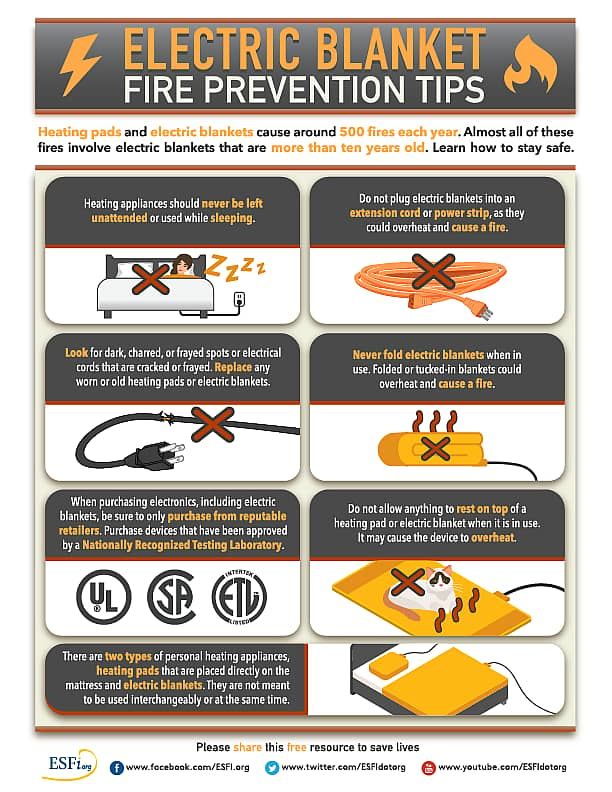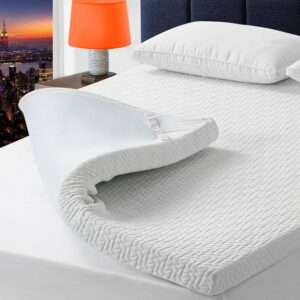Page Contents
ToggleHeating pads provide targeted heat for specific areas, while heating blankets offer full-body warmth. Both have unique benefits and uses.
Heating pads and heating blankets are popular solutions for staying warm and alleviating pain. Heating pads are ideal for addressing localized pain, such as sore muscles or joint discomfort. They deliver direct heat to the affected area, making them efficient for targeted relief.
Heating blankets, on the other hand, are perfect for providing overall warmth, especially during cold nights. They cover a larger area, ensuring your entire body stays warm. Choosing between a heating pad and a heating blanket depends on your specific needs, whether you require localized heat or full-body comfort.

Credit: www.aireserv.com
Heating Pads
Heating pads are popular for relieving pain and providing warmth. They come in various types, materials, and sizes. Understanding their benefits and safety is essential.
Types Of Heating Pads
- Electric Heating Pads: Plug into an outlet and provide consistent heat.
- Microwaveable Heating Pads: Heated in the microwave for quick use.
- Chemical Heating Pads: Use chemical reactions to generate heat.
- Infrared Heating Pads: Use infrared light to penetrate deeper into muscles.
Benefits And Uses
- Relieves muscle pain and stiffness
- Reduces inflammation
- Helps with menstrual cramps
- Improves blood circulation
- Provides comfort and warmth
Common Materials
| Material | Description |
|---|---|
| Fabric | Soft and comfortable, often washable. |
| Gel | Retains heat well, moldable to body contours. |
| Foam | Provides cushioning and insulation. |
| Plastic | Durable and easy to clean. |
Safety Considerations
- Avoid sleeping with the heating pad on.
- Check the pad for damage before use.
- Do not use on broken skin.
- Follow the manufacturer’s instructions.
- Keep away from water to avoid electric shock.

Credit: www.medicalnewstoday.com
Heating Blankets
Heating blankets provide warmth and comfort during cold nights. They are a popular choice for those seeking relief from the chill. Heating blankets come in various types and materials, each offering unique benefits.
Types Of Heating Blankets
- Electric Heating Blankets: These use electricity to generate heat. You can adjust the temperature with a control dial.
- Battery-Operated Heating Blankets: These are portable and powered by batteries. They are great for outdoor use.
- Microwavable Heating Blankets: Heat these in the microwave for a quick and easy warm-up. They are safe and convenient.
Advantages And Applications
Heating blankets offer many advantages and applications. They can help relieve muscle pain and improve blood circulation.
| Advantage | Application |
|---|---|
| Provides consistent warmth | Sleeping, lounging |
| Energy efficient | Reducing heating costs |
| Portable options | Outdoor activities |
Material Choices
Heating blankets come in different materials. Each material has its own benefits.
- Fleece: Soft and cozy, ideal for cold weather.
- Microfiber: Lightweight and durable, easy to maintain.
- Cotton: Breathable and natural, good for sensitive skin.
Safety Tips
Using a heating blanket requires some safety precautions. Follow these tips to stay safe:
- Always read the manufacturer’s instructions before use.
- Do not use a damaged or frayed blanket.
- Do not leave the blanket on while unattended.
- Keep pets away from the heating blanket.
- Do not use on infants or those who cannot adjust the temperature.
Cost Comparison
Choosing between a heating pad and a heating blanket can be tough. One crucial factor to consider is the cost. This section will break down the costs of each option.
Price Range
Heating pads are generally more affordable. You can find a quality heating pad for $20-$50. Heating blankets, on the other hand, tend to be pricier. Their price range is usually $50-$150.
| Product | Price Range |
|---|---|
| Heating Pad | $20-$50 |
| Heating Blanket | $50-$150 |
Long-term Investment
Heating pads have a shorter lifespan. You may need to replace them every 1-2 years. Heating blankets often last longer. With proper care, they can last 3-5 years.
- Heating Pads: Replace every 1-2 years.
- Heating Blankets: Replace every 3-5 years.
Maintenance Costs
Maintenance costs also differ between the two. Heating pads are easy to clean. Most are machine washable. Heating blankets require more care. They may need special cleaning instructions.
- Heating Pads: Simple and often machine washable.
- Heating Blankets: May need special cleaning instructions.
Consider these factors when deciding. Make a smart choice for your budget and needs.
Energy Efficiency
Choosing between a heating pad and a heating blanket depends on energy efficiency. Each option offers unique benefits. Understanding energy use helps make an informed choice.
Power Consumption
Heating pads and heating blankets consume different amounts of power. Heating pads use less electricity. They are smaller and heat specific areas. Heating blankets cover the whole body. They use more power due to their size.
| Heating Device | Average Power Consumption |
|---|---|
| Heating Pad | 20-70 watts |
| Heating Blanket | 100-200 watts |
Eco-friendly Options
Consider eco-friendly heating options. Look for devices with lower wattage. Some heating pads use renewable energy sources. Some blankets have energy-saving modes. These options reduce your carbon footprint.
Cost-saving Tips
Save money with these tips:
- Use a timer to limit usage.
- Opt for lower settings on your device.
- Unplug when not in use.
Heating pads are cost-effective. They use less power. Heating blankets save money by covering a larger area. Choose based on your needs and budget.
Portability
One of the key considerations when choosing between a heating pad and a heating blanket is portability. Whether you need heat therapy on the go or just want something easy to move around the house, understanding the portability aspect is crucial.
Ease Of Transport
Heating pads are typically more compact and lightweight. They can be easily folded and stored in a bag. Their small size makes them ideal for carrying to the office or gym.
Heating blankets, on the other hand, are usually bulkier and heavier. This can make them more challenging to transport. They require a larger space for storage and may not fit easily in a small bag.
Best For Travel
If you travel frequently, a heating pad is generally the better choice. Its smaller size and light weight make it easy to pack in a suitcase or carry-on.
Heating pads also often come with a travel pouch, adding to their convenience. In contrast, heating blankets are less practical for frequent travelers due to their size and weight.
Compact Options
| Feature | Heating Pad | Heating Blanket |
|---|---|---|
| Size | Small and foldable | Large and bulky |
| Weight | Lightweight | Heavier |
| Storage | Easy to store | Needs more space |
Both heating pads and heating blankets have their unique advantages. For those who prioritize portability, a heating pad is generally the better choice. Its compact size and ease of transport make it ideal for on-the-go use.
User Preferences
Choosing between a heating pad and a heating blanket can be hard. Each user has unique needs and preferences. Let’s explore these differences in detail.
Personal Comfort
Personal comfort varies between users. Some prefer the localized warmth of a heating pad. It targets specific areas like the back or shoulders. Others enjoy the full-body warmth provided by a heating blanket. It covers a larger area, giving a cozy feeling.
Here’s a quick comparison in a table:
| Feature | Heating Pad | Heating Blanket |
|---|---|---|
| Target Area | Specific Parts | Full Body |
| Portability | Highly Portable | Less Portable |
| Usage | Short-term Relief | Long-term Comfort |
Health Considerations
Health considerations play a key role in choosing the right product. A heating pad can help with muscle pain and joint stiffness. It provides quick relief by focusing on specific areas. A heating blanket can help improve blood circulation and offer overall relaxation.
- Heating Pad: Ideal for targeted pain relief.
- Heating Blanket: Great for overall warmth and comfort.
User Testimonials
Real user experiences can guide your decision. Here are some testimonials:
“I love my heating pad for my sore back. It’s a lifesaver!” – Sarah
“My heating blanket keeps me warm all night. It’s super cozy.” – John
Both products have their fans. Your choice depends on your specific needs and preferences.

Credit: twitter.com
Frequently Asked Questions
Which Is Better, A Heating Blanket Or A Heating Pad?
A heating blanket covers a larger area, ideal for warming the whole body. A heating pad targets specific spots, perfect for localized pain relief. Choose based on your needs.
Can A Heated Blanket Work As A Heating Pad?
No, a heated blanket cannot replace a heating pad. Heated blankets provide general warmth, while heating pads target specific areas for pain relief.
Is It Safe To Leave A Heating Pad On All Night?
No, it’s not safe to leave a heating pad on all night. It can cause burns or start a fire. Use it for short periods only and follow safety instructions.
Is It Good To Sleep With A Heated Blanket Every Night?
Sleeping with a heated blanket every night can be safe. Ensure the blanket has safety features and follow manufacturer instructions. Avoid overheating and check for wear and tear regularly. Consult your doctor if you have medical conditions.
Conclusion
Choosing between a heating pad and a heating blanket depends on your needs. Heating pads offer targeted relief, ideal for specific aches. Heating blankets provide overall warmth, perfect for cold nights. Evaluate your preferences and make an informed choice. Both options can enhance comfort and well-being effectively.



